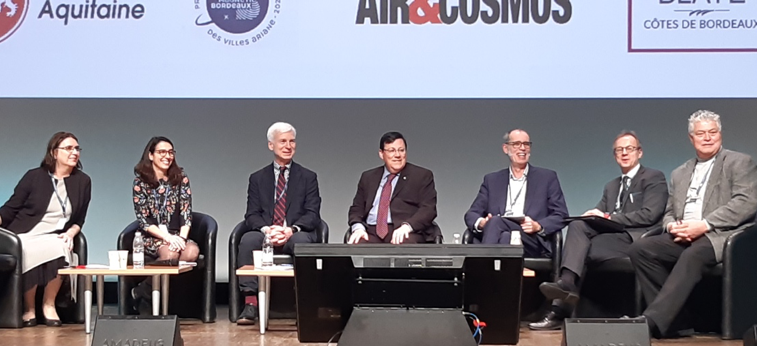ANIMA Project at Aerospace Europe Conference 2020: Outcomes
March 25, 2020
The ANIMA project took on a central role at the Aerospace Europe Conference (AEC2020), making its results available to the research community and beyond. Attendees were able to test the latest versions of the ANIMA tools and to get an overview of aviation noise research efforts at European level. ANIMA also led a session dedicated to noise impacts, where project partners displayed their latest research studies.

1 ANIMA project stand at AEC2020
Between 25-27 February 2020, the ANIMA project took part in the Aerospace Europe Conference (AEC2020), an event which featured 3AF 3rd Greener Aviation, CEAS 7th Air & Space Conference and the 8th edition of Aircraft Noise and Emissions Reduction Symposium (ANERS). AEC2020 also included an exhibition, giving the opportunity to research projects to communicate and disseminate their results to a large audience of policymakers, researchers, engineers, industry, academia and media.
ANIMA had its own stand at the exhibition, giving direct access to visitors to the project results, such as the latest project publication on land-use planning (Land Use Planning: A Key Approach to Reduce Airport Noise Annoyance), the virtual community tool, the audio-visual simulator of air traffic scenarios, and the common strategic research roadmap for aviation noise reduction. The ANIMA booth also called attention to the collective European aviation noise research efforts. Besides ANIMA, other EU-funded projects were exhibited at the booth, such as ARTEM, AERIALIST, RUMBLE and others. For a complete overview of the aviation noise research projects supported by INEA (the Innovation and Networks Executive Agency), please click here.
ANIMA tools: Virtual Community Tool & Virtual Community Noise Simulator
Participants passing by the ANIMA stand were able to test the Virtual Community Tool and the Virtual Community Noise Simulator (VCNS). There was a large public interest in the project and the booth saw interest from researchers, policymakers, industry and noise experts. In particular, Hervé Martin, Head of Unit at the Directorate-General for Research of the European Commission and James Hileman, Chief Scientific and Technical Advisor for Environment at the American Federal Aviation Administration payed a visit to the ANIMA booth.

2 Hervé Martin, Head of Unit, DG Research, testing the VCT at the ANIMA stand
The Virtual Community Noise Simulator (VCNS) allows for the integration of audible and visual aircraft noise-related information in interactive land-use planning settings, using a Virtual Reality headset. It is equipped with ANIMA-specific soundscaping scenarios, such as an Airbus A380 or a revolutionary blended-wing body (BWB) designed aircraft flyover. The application is meant for engaging communities in discussions about aircraft noise and mitigating measures. At the ANIMA stand, visitors were able to experiment with current and future air traffic scenarios, thanks to this demonstrator.
ANIMA’s Virtual Community Tool aims to support the mapping of adverse effects of aircraft noise, such as sleep disturbance and community annoyance. This tool is expected to allow policymakers and spatial planners to envision scenarios and associated technologies that could mitigate these effects.
Special ANIMA session on noise impacts at AEC2020
ANIMA is not a traditional aviation noise research project, as it rather focuses on people and on improving their quality of life rather than reducing the noise at source. The added value of ANIMA is the fact that it goes beyond noise, by taking non-acoustical factors into consideration.
The ANIMA researchers acknowledge that aircraft noise annoyance is influenced by non-acoustical factors (e.g. attitude towards the noise source, trust, perceived fairness). Addressing most of these factors can be assisted through transparent communication and information provision. Graeme Heyes, from Manchester Metropolitan University, explains that “airports are essentially in a negotiation with communities for a ‘license to operate’. Airports need to continue to manage down noise exposure through the Balanced Approach, but they can also play an active role in addressing non-acoustical factors. Giving the public a fair say, levelling hierarchies of expertise and making knowledge a public owned concept are some of the elements at the core of a good airport-community relationship. Communication and engagement are key in this process”.
From COMOTI (National Research and Development Institute for Gas Turbines), Narcisa Burtea adds that “noise complaint management and noise reports can support the common understanding of notions and can open up a channel of communication between airports and local communities”.
Laurent Leylekian, the ANIMA project coordinator, highlights as well that “communication should be underpinned by a fair ‘common language’ that is made comprehensible to all, so that decision-making processes are inclusive, transparent and allow the validity of claims to be challenged”. He also underlines that “engaging in such a dialogue forum processes implies to be ready to endorse its conclusion, a prerequisite which is not always obvious”.
While more guidance on noise impact and noise exposure is needed, communication and dissemination efforts can contribute to creating an environment of trust. Continuous communication and engagement with all relevant stakeholders can support decision-making, implementation and evaluation of noise interventions.
Environmental interdependencies – decarbonising the aviation roadmap
The ANIMA project takes further steps, considering interdependencies associated to change(s) at the local airport level, thus global interdependencies are out of scope. Considering interdependencies or trade-offs of the proposed action(s) and/or alternatives is particularly important when using results to inform decision making, or conducting an environmental assessment, to avoid, where possible, any unintended consequences. Aviation noise and emissions trade-offs, though needed by airports to design an informed strategy, seem not to be in focus. Noise and emissions are frequently considered independently and not in a holistic way. ANIMA aims to contribute to a better understanding and added knowledge to the concept of interdependencies and to investigate additional metrics and tools that could support the implementation process. Decarbonising the aviation roadmap is top priority in Europe and worldwide, therefore it is imperative to design and include the noise and emissions trade-offs contribution to this roadmap.
 3 Interdependencies speakers’ panel
3 Interdependencies speakers’ panel

